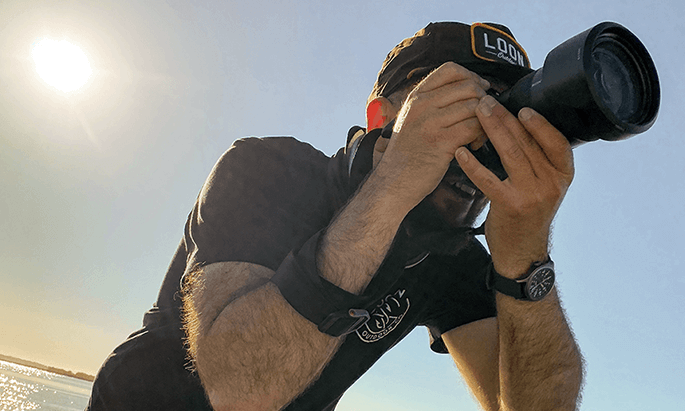The Pull: The Fish That Haunts My Dreams

It’s 6:30AM and I’m lost. Wandering through a train station in downtown Edinburgh, Scotland, I’m frantically reading signs for the correct train platform that will take me to Dalmeny station where my guide for the day will be picking me up. I’m thankful the signs are in English after a few days in Holland, but I’m still lost. My wander turns to a power-walk, then to a light jog. It’s the 19th of September, the day of Queen Elizabeth’s funeral. This means that most shops are closed and the train station is all but a ghost town. If I miss this train, there won’t be another for at least an hour due to limited services in observance of the Queen.

I find a train station worker that I can ask for help. “I’m looking for platform 18 - the train headed to Dalmeny.” Luckily, the man points in the correct direction while talking in a heavy Scottish accent. I’m reminded that although we both speak English, it’s a very different English. I’m straining to understand as much as I can, a common theme for the week in Scotland that gives me a much better view of just how big the world truly is.



I arrive in Dalmeny on time, somehow, and my guide is soon pulling into the parking lot. I walk towards what I think is the passenger side of the car only to be reminded that they drive on the other side of the road here - another common theme for the week.
“Happens all the time - but I’m the captain of this ship” my guide says jokingly. My guide for the day is Callum Conner - head guide of Scotia Fishing and a very talented fly caster, guide, and photographer. Callum speaks with a heavy Scottish accent, born and raised in Edinburgh, Scotland. He’s much younger and modern (for lack of a better word) than what I had imagined. This brings me a bit of relief as I can much more easily relate to and converse with Callum. We trade fishing stories throughout the hour drive north towards the River Tay through the foothills of the Scottish Highlands as Ice Cube and other West Coast rap plays through the speakers. Reminds me of home.
When researching salmon fishing in Scotland I had been overwhelmed with photo’s of fisherman, guides and ghillies fancily dressed in tweed, bunnet hats and sport coats so I was very relieved to see Callum dressed in normal fishing attire. A ghillie, or gillie, is an ancient Gaelic term for one who acts as a servant or attendant during a day of fly fishing on Scottish Highland rivers. They are responsible for the safety and enjoyment of those fishing on their stretch, or beat, of the river. This is a full time job, and Ghillies dedicate their lives to a specific stretch of river. 6 days a week are spent on the river, for decades and decades. They are well respected and have an incomprehensible knowledge of their home river and all of it’s nuances. Their advice is invaluable when chasing a fish of ten thousand casts.


As we pull in to the lodge (more of a hut) on the Lower Kinnaird estate of the River Tay we are greeted by the ghillie, Martin Edgar. Martin is the real deal. Dressed head to toe in traditional Scottish garb, he speaks with a heavy Scottish accent as he informs us of the current fishing conditions. “I caught two last week, they’re here.” he says. I quickly gather that Martin is an excellent fisherman in his own right. Martin is responsible for ensuring that guests feel comfortable throughout their day of chasing Atlantic Salmon, offering us a cup of hot coffee from the well-equipped fishing hut. He’s also responsible for choosing which beat of the river each of us is allowed to fish for both the morning and afternoon sessions. We’re granted access to Junction Pool in the morning, and the Ash Trees Pool in the afternoon. Ash Tree is the favorite of Callum’s so we have that to look forward to.



Junction Pool is beautiful. Tannic (tea-colored) water surrounded by a lush forest of Scots Pines. It gets it’s name from the convergence with the River Tummel tributary. Callum hands me a very long rod - somewhere between 13’ and 15’. It feels like a telephone pole when compared to the lighter 12’ rods we fish back home, but I revel at the chance to cast a true traditional Spey rod in it’s home country. It takes me longer than expected to dial in my casting. Casts of 100’ are required here to give yourself a chance at reaching fish. Callum in an excellent caster and instructor, former committee member of Scottish Game Angling Instructors and the youngest to have achieved both SGAIC qualifications in single and double hand fly fishing. Fishing for salmon, much like the steelhead of my home country, requires thousands of long casts to give yourself half a chance at hooking a fish. It’s akin to buying lottery tickets and the more quality casts one can make, the better the odds.



I’m very concentrated on not embarrassing myself while casting in front of Callum while trying to get myself into the rhythm of casting my line, swinging the fly across the pool, then taking 3 steps down stream to ensure the entire run is covered.
Splash!
The first one catches me off guard and it sounds as though a cannonball was launched into the river just above my right shoulder. I turn to Callum who is watching me from up on the bank. “Was that a fish?” I ask. “Aye!” Callum responds. Before long there are many fish jumping - or showing themselves - throughout the pool. After a few rogue splashes, I finally get a glimpse at one as I happened to be looking in the right direction when a large fish porpoises like a dolphin. These salmon are in their full spawning colors of browns, reds and oranges. The reason they jump and boil isn’t entirely known, but is most likely in response to the raging hormones their bodies are experiencing. “The males are all horned up” Callum exclaims. Soon after I feel a sharp tug on the line and I instinctively lift up on the rod. More of a flinch to be honest. Callum explains that I must wait a few seconds until line has been pulled off of my reel before steadily lifting the rod to set the hook. “Was I too quick on that one?” I ask, already knowing I’ve fucked this one up. “Aye, let it develop.” Callum replies. The steelhead I’m used to fishing for take a fly with such aggression that the rod is often bent in half before my brain has even had time to realize what’s happening.



I tell myself to let the next salmon chew on it before making any sudden movements. “Chew” may be the wrong word, as salmon do not feed in fresh water. Why a salmon really takes a fly, nobody is certain. The best theory is that it’s thought to be a combination of aggression, curiosity, and a conditioned response from when they fed in saltwater.” I’m unsure why I flinched when I felt the sharp tug, as I had also just read the very opposite that same morning. “We’re not always sure what going on underwater during a take, but I know you need to wait for the deep pull.” writes Steffan Juhl of the Salmon Junkies blog. Clearly, there’s a lot of unknowns when it comes to swinging a fly for salmon.
I fish through the entirety of the pool without another grab. Somewhat frustrating as the amount of salmon jumping and boiling throughout is astounding. I head back to the top of the run where I had felt my first tug for a second pass. I’m fishing a heavy fly pattern known as a Red Francis to get down deep. “This time of year you’ve got to tickle them on the nose to get a bite.” Callum tells me. Far from the romanticized traditional method of “skating” a fly in the surface and enticing a salmon to move for it, but I’m willing to try anything to catch one of these magnificent creatures.

Callum is in the river wading with me just off of my left shoulder. He tells me to keep the butt of the rod pinned to my thigh with my arms relaxed so as to keep myself from prematurely setting the hook on the next one. No sooner that I take this advice and I can feel my rod vibrating. Not shaking or bending, just a steady pull of the line from my reel. Something alive has taken my fly and is moving downstream with it. We watch as my reel makes 3 full turns before Callum instructs me to lift the rod while clamping down on the reel to set the hook. I lift up and feel a bit of weight and my heart feels like it’s going to explode out of my chest. Then nothing… Whatever took my fly has spit the hook and I’m left shaking and wondering if I waited too long or not long enough. Callum assured me I did everything right and that even in the best of scenarios there are no guarantees. This happens often. “Cheeky bastard!” I hear throughout the day while recounting what had happened. I’m torn up over the thought of what could have been. I’ve travelled 5,000 miles and paid $500 for my shot at catching an Atlantic Salmon and I’m fully aware that I may have just missed my best chance.
I continue to fish through the run for the remainder of the morning. There’s a mandatory lunch break between 1:00 and 2:00 to let the water rest before the next angler fishes each run. As I’m casting I hear Callum call me over, and I’m surprised to realize that he’s been cooking our lunch from up on the river bank. I’m making my way up the gravel bar I’m greeted by the sight and smell of a delicious venison burger with what I think is a chili jam sauce. A far cry from the cold deli sandwich I was half expecting and an even farther cry from the well-overcooked “brick” burgers we experienced the night before in downtown Edinburgh. I quickly learned that governmental laws in Scotland that prevents any burger meat from being under cooked, making them mostly inedible. There’s no substitute for a hot meal on a cold, fishless day and I’m pleasantly surprised at how good Callum’s venison burgers are.
“Would you like something to drink?” Callum asks. “Maybe a beer or a dram of whiskey?”
It’s only noon but I say “Whiskey sounds great, when in Rome I guess.” Callum smiles and reached for a bottle of Jura 10 year. Before long I’ve got a belly full of venison and whiskey as we head back to the fishing hut for the remainder of the lunch break. We walk in to a lively conversation over glasses of wine between the other anglers, guides and Ghillie Martin. Callum pours us a cup of coffee and we settle in.

“Where are you from?” Asks another angler. “San Francisco, a long way from home.” His eyes light up. We all trade stories of travel, comment on how much later the Scots eat dinner than us in the States, and chat about how many salmon we’re seeing in the river that don’t seem to want to eat a fly. “Stuffed with them (salmon)” Martin remarks. Further confirming that while the odds are always low when fly fishing for salmon, there’s still a chance.
I’m excited to head down river to Callum’s favorite pool and anxiously await the end of our lunch break. Before long we’re driving through farmland and private properties on our way to the afternoon beat. Ash Trees Pool is beautiful water for swinging a fly. Not quite the scenery we experience at Junction that morning, but I’ll gladly trade the scenery for a better chance at fish. I overhear Callum on the phone with another guide as he recounts the two pulls we had earlier that day. He seems excited and optimistic at my chances of sealing the deal in the Ash Trees pool.


Ash Trees is a bigger piece of water. We see fish rolling and jumping throughout the pool as we walk down the gravel bar. “Start here.” Callum says. He instructs me to stay within a rod’s length from the gravel bar. “Martin often says there’s no need to wade past your shins.” I follow his advice and begin blasting casts across the river. Cast, swing, step, repeat. Over and over until my arms are sore. The sun is starting to set and while I’m not giving up hope, I’m starting to come to the realization that I likely won’t catch a fish. A lump in my throat forms as I try to grapple with the thought that I may never be able to return. It’s a huge undertaking to even get this far across the globe and likely means I’d have to take some other destination off of my bucket list in lieu of a second trip back here. As I’m zoning out and contemplating all of this, a gigantic male salmon with a huge kype and red stripe across his cheek porpoises out of the water in front of me, but well out of casting range. I’m reminded that I’m lucky enough to even experience the sight of this, but I’d be lying if I said I wouldn’t kill to have one of these fish eat my fly.
Callum asks if he can fish behind me on my next pass down the run. I don’t hesitate in saying I’d love to have him join me. I’m inspired by his optimism and beautiful casting, and if for no other reason I’d like to know if it’s me or the river that is responsible for the lack of interest from these fish. His casting is truly amazing, a lifetime of effort spent casting on the wide rivers of Scotland. Confirming that these fish are as unpredictable as the world we live in, he comes up empty handed as well - save for two beautiful, native brown trout. I’m excited to see any form of life pulled from the river, but it’s certainly a consolation prize.



“Callum tells me that “a fish” refers to an Atlantic Salmon around here. One wouldn’t say they “got a fish” after landing a brown trout, sea trout, or grayling, they reserve that title for encounters with the king of fish. “The Atlantic Salmon, the King of Fish, needs no introduction. In my opinion, catching an Atlantic Salmon in the rivers of Scotland is the ultimate achievement in the sport of fly fishing.” says Callum at the end of the long day. He tells me there’s other places around the world with far better catch rates, but adds that none of these places have the history or mystique surrounding their Atlantic Salmon runs. I’m temporarily tempted at the thought of catching one of these special fish in a place where my odds would be much better, but I quickly remind myself that there would be no sweeter reward than getting one here in The Highlands.

Later that night I feel line from my reel being pulled steadily. I wait for the grab to develop before trying to lift the rod to set the hook, but I’m unable to lift my arms. I shoot up out of bed. It’s 2:00 AM. The King of Fish haunts my dreams.



